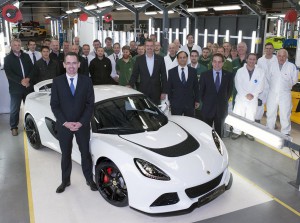
Lotus CEO Jean-Marc Gales has the company is taking a common sense approach to recovery, which now likely includes an SUV.
Less than a year ago senior leaders at Lotus were scrambling to determine if the British sports car maker could keep going. What a difference a few months makes; now they’re trying to decide if they should add a sedan or a sport-utility.
“I’m a bit torn between an SUV and a four-door sports car – but in the end I can see that the SUV has the bigger market,” Lotus CEO Jean-Marc Gales told Reuters. “We’d do an SUV that is very light, very fast on the track and has outstanding handling.”
Regardless of the choice, it sounds like Porsche could be in line for some competition for the Panamera, Cayenne or Macan, which is exactly where Gales drew his inspiration from for the new product plan last fall.
Infused with a bit of cash from Malaysian parent company DRB-Hicom, Lotus has been working its way back from in-fighting, lawsuits and product problems that have been the source its long-rumored demise.
However, instead of going under, it recently introduced its all-new, mid-engined Evora 400.
The latest update of the Evora line is more than just a cosmetic update, insists the maker, which is based in Hethel, Norfolk. It claims that “over two-thirds” of the Lotus Evora 400 is new, including its supercharged 3.5-liter V-6.
With that mid-mounted V-6 making 400 horsepower and 302 pound-feet of torque, Lotus claims the new Evora 400 can launch from 0 to 60 mph in just 4.1 seconds, with a top speed of 186 mph. It also reports the new model has been lapping the test track at its headquarters six seconds faster than the previous Evora.
(Struggling Lotus unveils new Evora 400. For more, Click Here.)
The new model retains the underlying philosophy of Lotus founder Colin Chapman, adds CEO Gales. “We have always said that to make a car better, you must make it faster and lighter.”
The Evora 400’s new aluminum chassis and composite body weigh in almost 50 pounds lighter than the outgoing Evora, despite the additional power, at a base weight of 3,119 pounds.
(Click Here for details Lotus’ new approach: practicality.)
The Evora came out after the management team said it was taking 45 days to contemplate the company’s direction and cut 25% of the workforce last September.
Funding for future product was an issue, the products they did sell did appear that they would be available in the world’s biggest market – the U.S. – because they didn’t meet federal regulations for crashworthiness.
(To see more about Lotus’ plans for the U.S., Click Here.)
However, the staff righted the ship after the consultancy period, made the changes necessary for the Evora to be sold in the U.S. and put its global product portfolio on the right track. Now it more closely resembles the company that stormed the Paris Motor Show in 2010 touting five new models and a cutting-edge attitude.


The sad reality of life is that many people like SUVs even if they have no need for them. While there is certainly a need and place for SUVs, many buy them for status or other not so practical reasons. These SUVs are in many ways a “plague” on society but as long as they are in vogue, all major auto makers will sell them. It might take $5/gal. for fuel prices in the U.S. to curb the appetite for these luxo barges.
While Porsche’s SUVs and likely Lotus’s SUV will be distinctly performance oriented, excellent handling (for their mass and CG height), vehicles, they still are such a waste of energy in so many ways. Unfortunately auto makers need to sell what consumers desire.